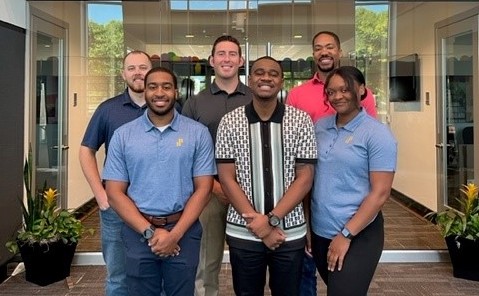How Synchrony helps veterans become IT leaders

Built-in mentorship to help build up veterans’ networks
Veterans are paired with a mentor during the program — either another veteran in the organization or someone within senior leadership. They work with that mentor for the first six-month rotation, and then are assigned a new mentor during the second six-month rotation. The goal is to help build their networks and to offer more guidance while making the transition to a civilian career. Mentors and mentees meet at least once per week for the first month, and then monthly after that.
“You’re connected with a mentor who has a relatable background and is in the same career field as your rotations. In my first rotation, my mentor was also an Operations Leader and prior Air Force like myself,” Hodge says. “Switching to technology for my second rotation my mentor was an Applications Engineer and prior Navy. I continue to talk with both monthly and the conversations we have are wonderful, lower my stress, and have contributed to a comfortable and smooth transition.”
Beyond mentors, Hodge also notes that he was able to meet executives and senior leaders, helping him better “understand the business as a whole, how the company was organized, and learn the goals and vision of where we were headed.” When he expressed an interest in AWS, Hodge says these connections helped put him in touch with leaders on the technology and public cloud teams, laying the groundwork for his second rotation within Cloud Platform Engineering.
Bruce Spencer, a member of the Veteran Leadership Program and the Azure and Active Directory Authentication Team, found out about Synchrony’s program while attending a Service Academy Career Conference (SACC) event in 2022. He says he was drawn to the company’s culture and values.
Bruce Spencer, Synchrony
Synchrony
“The uniqueness of this program comes from your access to senior leaders as a member of the Veterans Leadership Program. I have not been in or seen an organization where I’ve been exposed to senior leaders within the organization — veterans and non-veterans — who take the time to speak with us directly and to make sure we’re successful,” says Spencer.
Campbell found that the program helped tremendously with transitioning both himself and his family out of the military. Prior to finding the Veteran Leadership Program at Synchrony, he says he struggled to tap into his network in the private sector and to effectively demonstrate to recruiters how his military skills translated to a civilian job.
“This program took a chance on me and placed me in different roles, assisted in networking and gave me the latitude to try different aspects that may or may not be a good fit. These factors greatly assisted in the overall transition process and boosted my confidence to be successful in a new career,” he says.
Eyes on the future
Currently, Synchrony has hired two separate classes of veterans into the organization through the program; moving forward the plan is to have everyone in one class per year to help alleviate some of the coordination issues required to run the program. With one class per year, Eubanks says Synchrony can better allocate HR resources, mentors, and the West Point training.

Veteran Leadership Program Group 2 participants
Synchrony
“Coordinating that twice a year was busy for us,” he says. “We’re glad to do it, but it would be easier if we just brought everyone in together at once. So we’re going to continue doing that going forward, because it really has yielded some really unique talents that we didn’t think we’d find.”
Moving forward, Eubanks says the success of the program will be evaluated by the demand for veteran employees, noting that “for the second class that we hired, we had essentially twice as many requests for the veterans as we did veterans.”
While the early signs of success are there, Eubanks notes that the long-term metrics of success will hinge on retention and employee satisfaction and engagement.
“We feel like by setting them up for success in a program like this, that they’re going to want to stay with Synchrony, right where they they’ve learned, grown, and developed. And I think that’s going to be the future metric that we’re going to track — how well do these veterans do here at Synchrony? The early indications are good, but I will really know that three to five years out,” he says.

